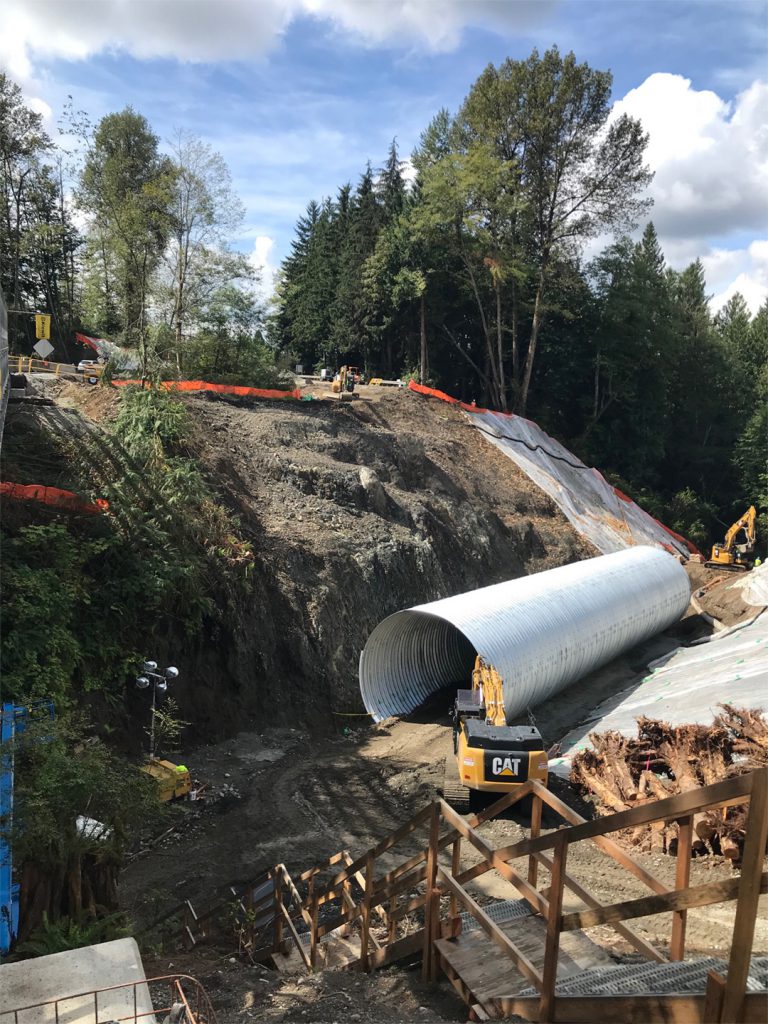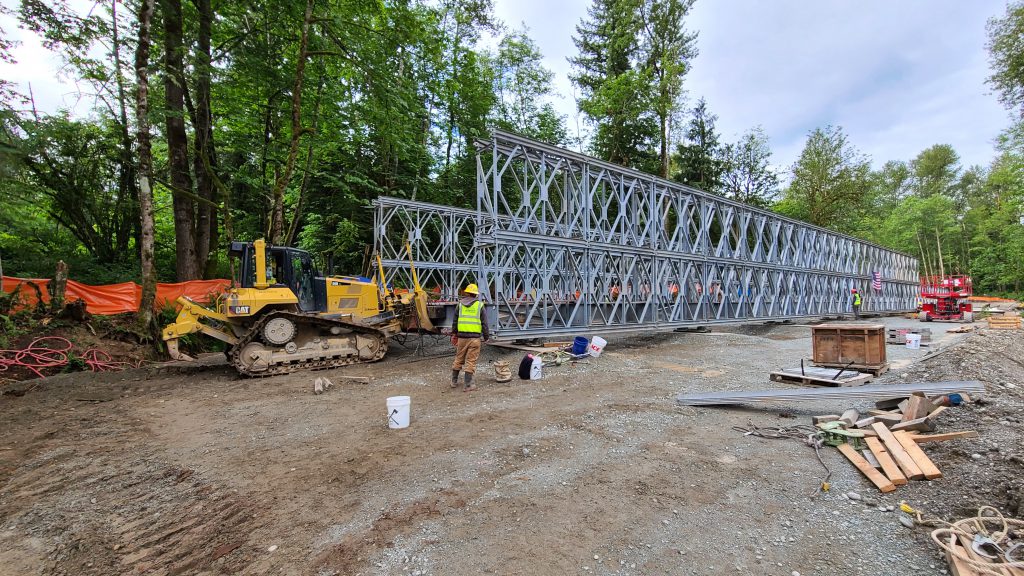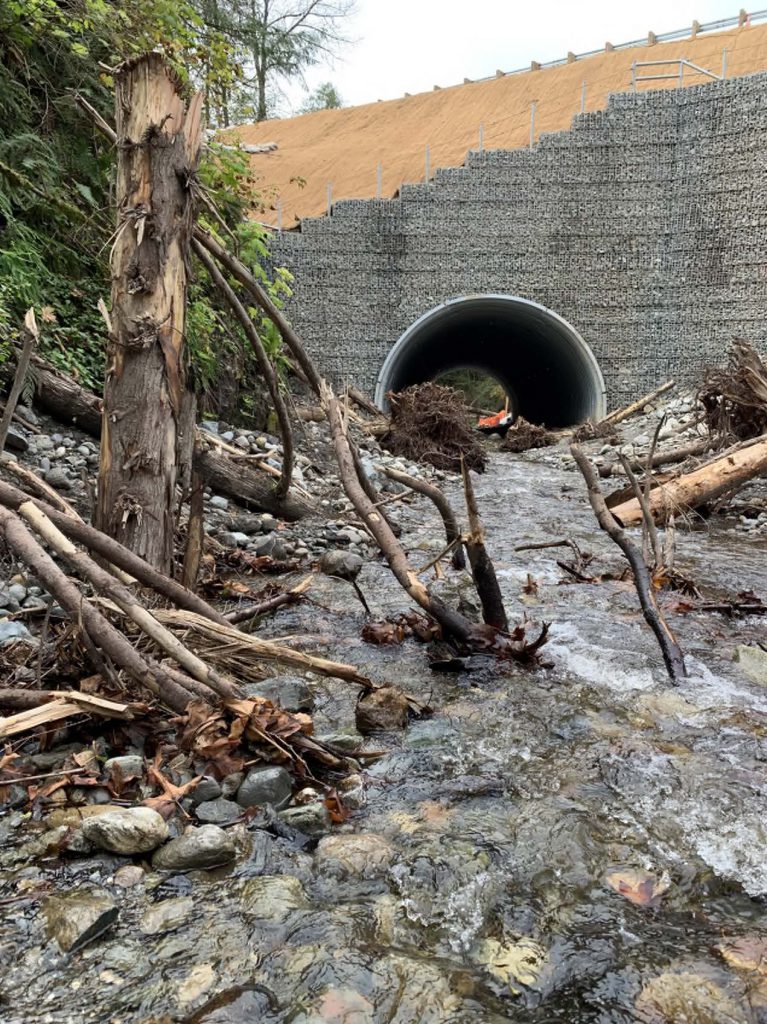If the fish could, they’d likely be applauding the recent improvements made at Trafton Creek.
The migratory and resident species that inhabit this stream that runs under State Route 530 in northwest Washington are finding it easier to navigate the waterway, thanks to a new water-crossing structure and streambed designed and built by Kiewit.
Earlier this year, the team completed work for the Washington State Department of Transportation (WSDOT) that included replacing a concrete culvert and building a natural habitat for Coho salmon, steelhead, and resident bull and sea-run cutthroat trout.
Trafton Creek is one of more than 800 sites in the northwest part of the state with culverts that are slated for replacement by WSDOT by 2030. The impetus for the upgrades was a legal request by 21 area Native American tribes to preserve fish runs, granted by the U.S. District Court.
‘Working on a postage stamp’
To prepare for culvert construction, Kiewit first had to build another structure — an approximately 1,000-foot-long temporary bypass lane, which included a 180-foot-long temporary bridge to span the creek, diverting traffic for about four months.
Making room for the new structure in the creek, as well as the access road, meant removing about 60,000 yards of soil.
“We were working in a postage-stamp size area,” said Construction Manager Mike Yedinak, which required some careful choreography of the landscape and the fish at the site.
Excavation could only go down to a certain elevation — the ordinary high-water mark — prior to the In-Water-Work window between July 15 and Sept. 30. At that point the existing creek could be diverted, and the concrete culvert removed.
To be able to work in a dry environment, Kiewit placed a diversion pipe to temporarily alter the flow of the water; a subcontractor was hired to remove and relocate the fish within the project limits.
Putting together a puzzle
With a drop too steep for most fish to traverse, the old culvert measured 48 inches in diameter and was 290 feet long.
The new structure is a roomy 26-foot diameter multi-plate round steel culvert. At 135 feet, it’s also shorter than the old one, which opens up additional streambed habitat and limits the amount of time the fish are in the culvert itself.
Assembling the culvert was like putting together a big puzzle, Yedinak said.
Crews started at the bottom to build the seven plates per ring that comprise the culvert. Each ring of plates — about 2 ½ feet wide by 8 feet long — required about 300 bolts for a total of 13,000.
“The tricky part was we had to build the culvert at the bottom of the excavation due to limited room both up top on the road and at the bottom of the cut,” said Yedinak.
“With rock outcrop on one side of the excavation and a resident’s driveway that had to remain accessible on the other, the overall footprint needed to stay as small as possible and still have the excavation maintain a certain slope for safety,” he said.
Building the habitat
Communication with the Native American tribes was a key part of the project, said Chris Parshall, who served as lead estimator and design coordinator.
Kiewit team members frequently met with tribe representatives to discuss the details of the project and also to understand their expectations.
While planning the design for the improved stream habitat, for example, the tribes said they preferred natural-looking features built out of wood, Parshall said.
“We buried logs and root wads in the stream, positioning them like a tree would be if it fell into the waterway and was either carried into the stream and stuck into the bank or just down into the stream.”
The bioengineered stream banks were constructed out of jute mat and a variety of species of trees and shrubs were planted in it. To reinforce the banks — at a steeper grade because of site constraints — a sediment-type of aggregate was used for backfill along with some topsoil.
Native species sourced from the project, whether shrubs or trees, have created an authentic habitat. The idea, Parshall said, is that some of them are going to grow quickly, die and then fall into the stream to contribute to the natural process.
Bringing together old and new
For Parshall, the project has been like a homecoming. He grew up six miles down the road in Arlington and was able to interact with people he remembers from childhood.
“Just down the street is the saw shop,” he said. “My dad dealt with him when I was a three- or four-year-old kid. I was talking with folks who are in my history.”
After serving as a superintendent for other Kiewit projects, this was Yedinak’s first as a construction manager.
“I was always the one just getting dirty and putting stuff together,” he said. “It’s definitely been a different take on things. It’s all new to me, so it’s been fun.”





